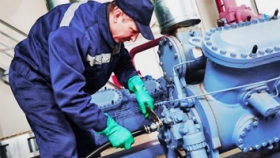Every technician who works with refrigeration systems, can raise the productivity of the system and prevent energy loss by taking two simple measures:
Maintenance: most technicians simply ignore refrigeration system maintenance operations. But if a system is not properly maintained, energy consumption gradually goes up. Simple works like cleaning condenser or leak detection can save energy.
Repair: accurate repairing the refrigeration system faults is also important. If it isn't done correctly, the energy consumption goes up. Refrigeration System troubleshooting and repair should be properly done to restore the system productivity to the desired level.
Factors affecting productivity of refrigeration system
- Refrigeration load
- Temperature difference
- Superheat and sub cooling
Charts below show how you can control these factors and raise the productivity of refrigeration system by affecting them.
Refrigeration load in refrigeration system
Refrigeration load should be kept at minimum.
Refrigeration load factors
Can you affect the factor?
1. Air exchange: warm air entering the room through open doors or air leaks in the room.
Yes
- Minimizing door opening time.
- Installing a strip or air curtain
- Training the customer and the staff about opening and closing doors.
- Repair and remove all leaking points.
2. Heat entrance: heat entering the room through damaged or incorrect insulation.
Yes
- Repair the room insulation.
- Bring the products into the room in the shortest time to prevent raising their initial temperature.
3. Heat coming from people and machinery in the room.
No
- But you can have necessary recommendations to minimize the energy loss.
4. Heat produced by defrost operation.
Yes
-
Make sure defrost process doesn't take longer than what is needed.
5. The way of organising products in the cold room
No
-
But give necessary commendations to the customer to maintain the good air flow in the room.
6. Heat coming from the suction line.
Yes
-
Insulate the suction line and repair existing insulation if necessary.
Note: repair the insulation of the walls as soon as possible.
Note: the suction line should be insulated and the insulation should be regularly checked.
Temperature difference in refrigeration systems
The difference between condensing and evaporator temperatures should be kept at minimum. The evaporator temperature should be kept high and the condensing temperature should be kept low.
Temperature difference factors
Can you affect the factor?
1. Condenser should be large and clean and there shouldn't be any airflow restriction.
Yes
- Clean the condenser regularly.
- Make sure all the fans and the pump works properly.
- In air-cooled condensers, make sure the air completely passes over the coils and fans are in good condition.
2. Evaporator should be large and clean with no frost
Yes
-
Make sure the defrost system works properly and its duration is compatible with the refrigeration system.
3. Refrigerant shortage can reduce evaporator pressure.
Yes
-
Carry out leak detection and repair any probable leak.
4. Air and non-condensable gases increase condenser pressure in refrigeration system.
Yes
- Remove non-condensable gases from the refrigeration system.
- Completely evacuate the system before the refrigerant charge.
5. Discharge pressure control: when the ambient temperature is low, keep the condensing pressure high.
Yes
-
If you have such a control on the refrigeration system, make sure it is not set too high.
6. High refrigerant volume increases condenser pressure.
Yes
-
Don't charge too much refrigerant in the system.
7. Clogged filter dryer increases the temperature pressure.
Yes
-
Clean or replace the clogged filter dryer.
8. Incorrect control settings: if thermostat and low pressure control are set too low, evaporator pressure decreases.
Yes
-
Adjust the controllers properly and give required recommendations for the customers.
Superheat and sub cooling in refrigeration system
Superheat and sub cooling factors
Can you affect the factor?
1. Superheat in suction line should be kept at minimum, about 5°C.
Yes
-
Adjust the expansion valve in order not to create higher superheat.
2. The output sub cooling liquid from the condenser should be kept at maximum.
Yes
-
If the liquid line passes through a warm space, make sure it is fully insulated.
Tip: superheat is the temperature difference between suction line and the evaporator.
Tip: sub cooling is the temperature difference between output liquid from the condenser and the condensing temperature.
Refrigeration system maintenance
- Clean the condensers and make sure they are in good condition.
- Make sure the output air from the condenser fans doesn't come back to the system and pay attention fans completely suction the air from the coil surface.
- Check the discharge line of evaporator defrost water. Make sure the defrost thermal element works properly.
- Make sure about the accurate defrost time and duration. The longer defrost duration raises the room temperature and the shorter duration leaves some frost and affects evaporator efficiency.
- Check the refrigeration system condensing pressure (discharge pressure) not to be too high.
- Check the refrigeration system about refrigeration leak. Large refrigeration systems with high numbers of fittings can have undistinguishable leaks.
- Close all valve caps in refrigeration system.
- Check the temperature difference in filter dryer. If it is less than 1, it means the filter is clogged.
- Check all the insulations and repair them if needed.
- Check the product arrangement in the system to make sure there is good air flow.
If you need more information about refrigeration systems and cold storage, you can use refrigeration system training course in HelloTechnic website. Our instructors will give you the recent information about refrigeration systems, cold rooms and chillers, their troubleshooting, service and repair to make you a professional repairman.


